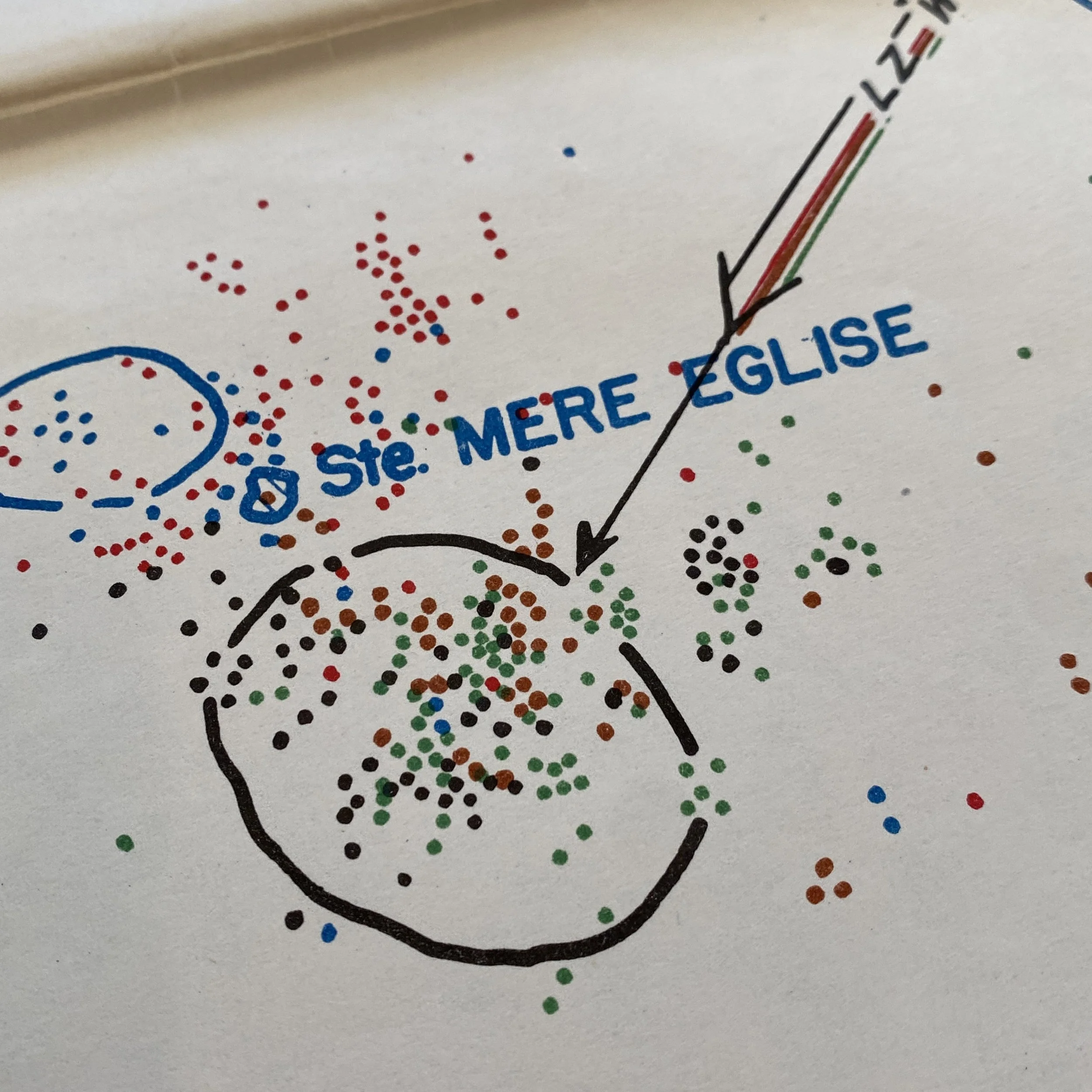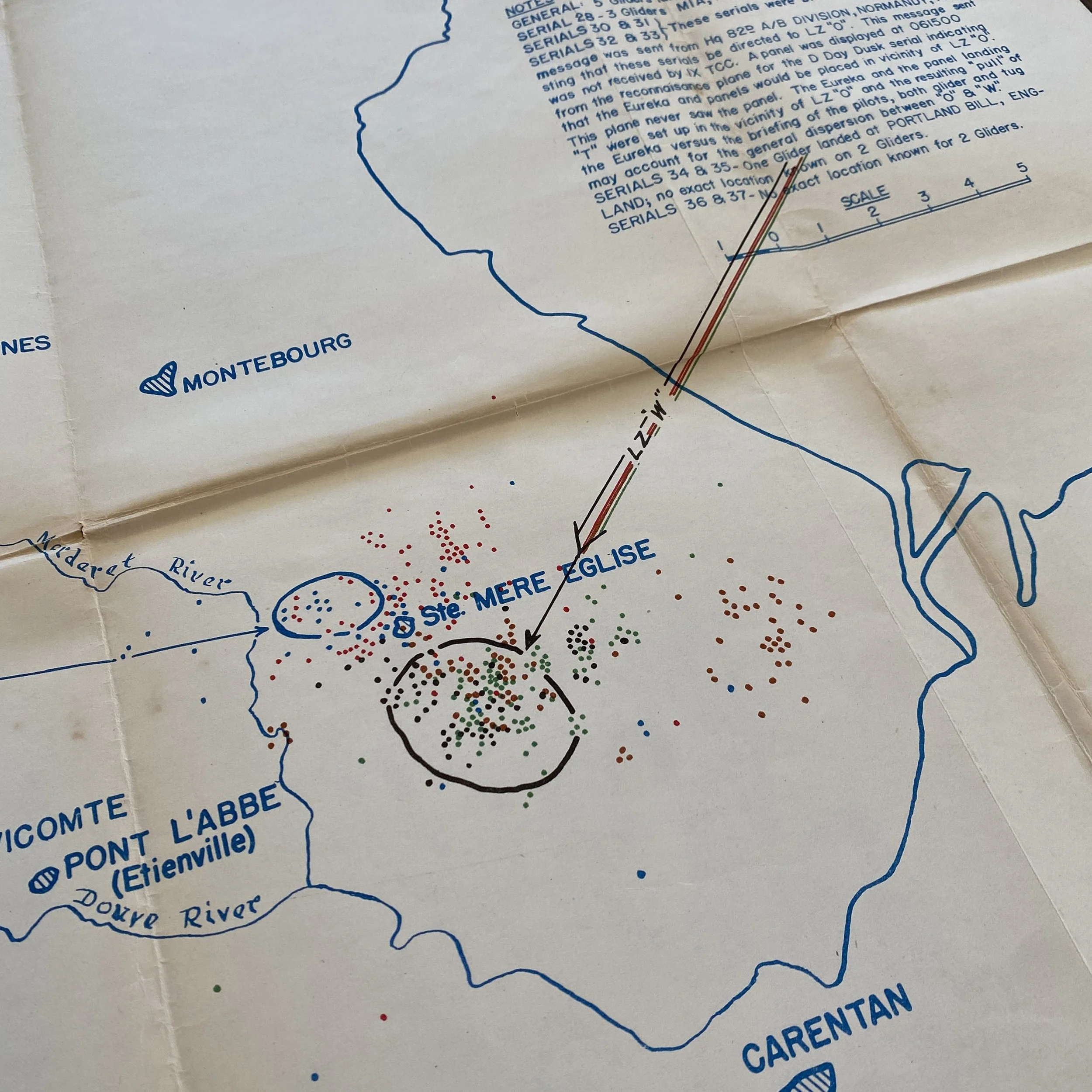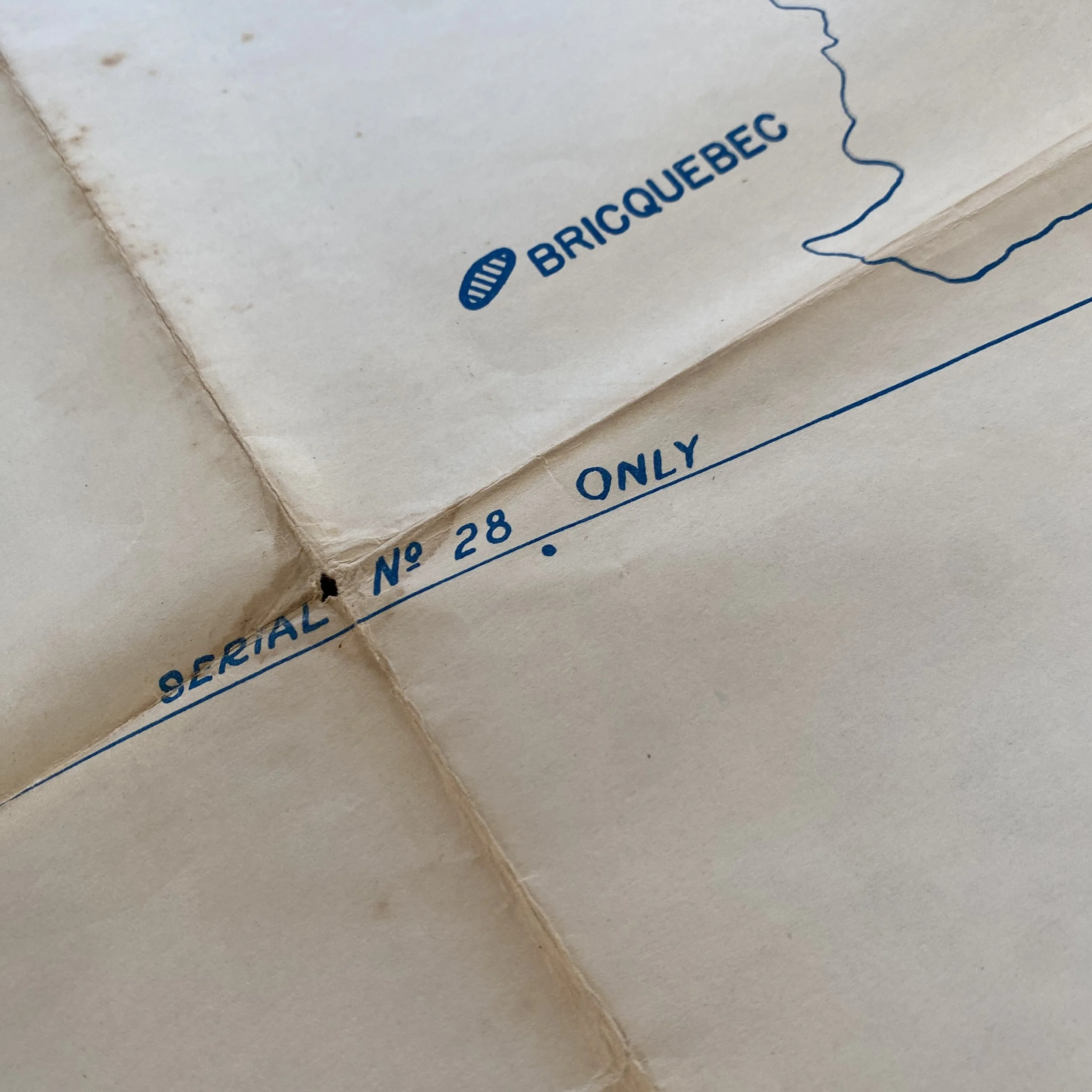VERY RARE! WWII 1944 Sainte-Mere-Eglise "NORMANDY GLIDER LANDING PATTERNS JUNE 6-7th 1944" Operation Overlord "RESTRICTED" After-Action Combat Intelligence Report Map - U.S. Airborne Ground Assault























VERY RARE! WWII 1944 Sainte-Mere-Eglise "NORMANDY GLIDER LANDING PATTERNS JUNE 6-7th 1944" Operation Overlord "RESTRICTED" After-Action Combat Intelligence Report Map - U.S. Airborne Ground Assault
Comes with a hand-signed C.O.A. and a multi-page historical researched write-up:
*In total, only 420 copies of this “CONFIDENTIAL” after-action map were created. This is the same original after-action D-Day map that was distributed to Generals Eisenhower, Marshall, Bradley, Ridgeway, Gavin, March, Eaton and other high-ranking officers. SEE LISTING PHOTOS FOR A DIGITAL COPY OF THE SECRET DISTRIBUTION LIST/COUNT.
This EXTREMELY RARE and museum-grade 1944 dated WWII Operation Overlord D-Day artifacts is one of a handful of original D-Day after-action combat report maps to exist detailing the U.S. AIRBORNE and GLIDER assault on D-Day June 6th, 1944. In total, only 420 copies of this “CONFIDENTIAL” after-action map were created.
Under General Eisenhower’s direction, 420 copies of these historical narrative reports were created using the exact “RESTRICTED” D-Day and D-Day + after-action combat reports of the 508th Parachute Infantry Regiment, 325th Glider Infantry Regiment, 82nd Airborne Division, 80th Airborne Antiaircraft Battalion, 307th Airborne Engineer Battalion, 307th Medical Company, and 82nd Airborne Signal Company.
Distributed a few weeks following the Operation Overlord D-Day assault of Normandy and were meant to visually detail the after-action reports of the U.S. Airborne operation in Normandy, France to high-command generals and officers. This was the second most SECRET document set that was produced by the Allies following the secrecy of the “TOP SECRET” BIGOT map distribution.
This very rare U.S. Airborne D-Day after-action combat report map was produced by the 669th Engineer Topographic Company and was created for high-command generals, officers, and Division HQs. What makes this map even more sought after is that there is a very detailed historical account of the exact distribution of each map.
This is the same original after-action D-Day map that was distributed to Generals Eisenhower, Marshall, Bradley, Ridgeway, Gavin, March, Eaton and other high-ranking officers.
Titled “NORMANDY GLIDER LANDING PATTERNS JUNE 6-7th 1944” this after-action map illustrates the SECRET Operation Overlord Airborne combat glider landing areas near Sainte-Mere-Eglise. This after-action map details the exact pinpoint landing location of each U.S. Airborne glider on D-Day on June 6th and D-Day +1 on June 7th, 1944.
American airborne landings in Normandy were a series of military operations carried by the United States as part of Operation Overlord, the invasion of Normandy by the Allies on June 6, 1944 during World War II. Approximately 13,100 American paratroopers from the 82nd and 101st Airborne Divisions conducted parachute drops, followed by 3,937 glider infantrymen, on June 6.[2] As the opening maneuver of the Normandy landings, the two American airborne divisions were dropped in Normandy via two parachute and six glider missions.
On April 12 a route was approved that would depart England at Portland Bill, fly at low altitude southwest over water, then turn 90 degrees to the southeast and come in "by the back door" over the western coast. At the initial point the 82nd Airborne Division would continue straight to La Haye-du-Puits, and the 101st Airborne Division would make a small left turn and fly to Utah Beach. The plan called for a right turn after drops and a return on the reciprocal route.
Airborne Assault into Normandy:
The airborne assault into Normandy, as part of the D-Day allied invasion of Europe, was the largest use of airborne troops up to that time. Paratroopers of the U.S. 82nd and 101st Airborne Divisions, the British 6th Airborne Division, the 1st Canadian Parachute Battalion, and other attached Allied units took part in the assault. Numbering more than 13,000 men, the paratroopers were flown from bases in southern England to the Cotentin Peninsula in approximately 925 C-47 airplanes. An additional 4,000 men, consisting of glider infantry with supporting weapons, medical, and signal units were to arrive in 500 gliders later on D-Day to reinforce the paratroopers. The parachute troops were assigned what was probably the most difficult task of the initial operation - a night jump behind enemy lines five hours before the coastal landings.
To protect the invasion zone's western extremity and to facilitate the "Utah" landing force's movement into the Cotentin Peninsula, the U.S. 82nd and 101st Airborne Divisions descended on the peninsula by parachute and glider in the early hours of D-Day. The paratroopers were badly scattered. Many were injured and killed during the attack, and much of their equipment was lost, but the brave paratroopers fought fiercely, causing confusion among the German commanders and keeping the German’s troops occupied. Their efforts; hampered by harsh weather, darkness and disorganization, and initiative of resourceful Soldiers and leaders, ensured that the Utah Beach assault objectives were eventually accomplished. The British and Canadian attacks also accomplished their primary goal of securing the left flank of the invasion force.
Combat Drop Missions:
The assault lift (one air transport operation) was divided into two missions, "Albany" and "Boston", each with three regiment-sized landings on a drop zone. The drop zones of the 101st were northeast of Carentan and lettered A, C, and D from north to south (Drop Zone B had been that of the 501st PIR before the changes of May 27). Those of the 82nd were west (T and O, from west to east) and southwest (Drop Zone N) of Sainte-Mère-Eglise.
Each parachute infantry regiment (PIR), a unit of approximately 1800 men organized into three battalions, was transported by three or four serials, formations containing 36, 45, or 54 C-47s, and separated from each other by specific time intervals. The planes, sequentially designated within a serial by chalk numbers (literally numbers chalked on the airplanes to aid paratroopers in boarding the correct airplane), were organized into flights of nine aircraft, in a formation pattern called "vee of vee's" (vee-shaped elements of three planes arranged in a larger vee of three elements), with the flights flying one behind the other. The serials were scheduled over the drop zones at six-minute intervals. The paratroopers were divided into sticks, a plane load of troops numbering 15-18 men.
To achieve surprise, the parachute drops were routed to approach Normandy at low altitude from the west. The serials took off beginning at 22:30 on June 5, assembled into formations at wing and command assembly points, and flew south to the departure point, code-named "Flatbush". There they descended and flew southwest over the English Channel at 500 feet (150 m) MSL to remain below German radar coverage. Each flight within a serial was 1,000 feet (300 m) behind the flight ahead. The flights encountered winds that pushed them five minutes ahead of schedule, but the effect was uniform over the entire invasion force and had negligible effect on the timetables. Once over water, all lights except formation lights were turned off, and these were reduced to their lowest practical intensity.
Twenty-four minutes 57 miles (92 km) out over the channel, the troop carrier stream reached a stationary marker boat code-named "Hoboken" and carrying a Eureka beacon, where they made a sharp left turn to the southeast and flew between the Channel Islands of Guernsey and Alderney. Weather over the channel was clear; all serials flew their routes precisely and in tight formation as they approached their initial points on the Cotentin coast, where they turned for their respective drop zones. The initial point for the 101st at Portbail, code-named "Muleshoe", was approximately 10 miles (16 km) south of that of the 82d, "Peoria", near Flamanville.
Detailed D-Day and D-Day + Airborne Ground Assault:
After 24 hours, only 2,500 of the 6,000 men in 101st were under the control of division headquarters. The 82nd had consolidated its forces on Sainte-Mère-Église, but significant pockets of troops were isolated west of the Merderet, some of which had to hold out for several days. The dispersal of the American airborne troops, and the nature of the hedgerow terrain, had the effect of confusing the Germans and fragmenting their response. In addition, the Germans' defensive flooding, in the early stages, also helped to protect the Americans' southern flank. The 4th Infantry Division had landed and moved off Utah Beach, with the 8th Infantry surrounding a German battalion on the high ground south of Sainte-Mère-Église, and the 12th and 22nd Infantry moving into line northeast of the town. The biggest anxiety for the airborne commanders was in linking up with the widely scattered forces west of the Merderet.
Many continued to roam and fight behind enemy lines for up to 5 days. The Air Force Historical Study on the operation notes that several hundred paratroopers scattered without organization far from the drop zones were "quickly mopped up", despite their valor and inherent toughness, by small German units that possessed unit cohesion. Most consolidated into small groups, however, rallied by NCOs and officers up to and including battalion commanders, and many were hodgepodges of troopers from different units. Particularly in the areas of the 507th and 508th PIRs, these isolated groupings, while fighting for their own survival, played an important role in the overall clearance of organized German resistance.
On June 6, the German 6th Parachute Regiment (FJR6), commanded by Oberst Friedrich August von der Heydte,[13] (FJR6) advanced two battalions, I./FJR6 to Sainte-Marie-du-Mont and II./FJR6 to Sainte-Mère-Église, but faced with the overwhelming numbers of the two U.S. divisions, withdrew. I./FJR6 attempted to force its way through U.S. forces half its size along the Douve River but was cut off and captured almost to the man. Nearby, the 506th PIR conducted a reconnaissance-in-force with two understrength battalions to capture Saint-Côme-du-Mont but although supported by several tanks, was stopped near Angoville-au-Plain. In the 82nd Airborne's area, a battalion of the 1058th Grenadier Regiment supported by tanks and other armored vehicles counterattacked Sainte-Mère-Église the same morning but were stopped by a reinforced company of M4 Sherman tanks from the 4th Division. The German armor retreated and the infantry was routed with heavy casualties by a coordinated attack of the 2nd Battalion 505th and the 2nd Battalion 8th Infantry.
101st units maneuvered on June 8 to envelop Saint-Côme-du-Mont, pushing back FJR6, and consolidated its lines on June 9. VII Corps gave the division the task of taking Carentan. The 502nd experienced heavy combat on the causeway on June 10. The next day it attacked the town, supported by the 327th GIR attacking from the east. The 506th PIR passed through the exhausted 502nd and attacked into Carentan on June 12, defeating the rear guard left by the German withdrawal.
On June 13, German reinforcements arrived, in the form of assault guns, tanks, and infantry of SS-Panzergrenadier-Regiment 37 (SS-PGR 37), 17. SS-Panzergrenadier Division. SS-PGR 37 and III./FJR6 attacked the 101st positions southwest of Carentan. The Germans pushed back the left of the U.S. line in a morning-long battle until Combat Command A of the 2nd Armored Division was sent forward to repel the attack. The 101st was then assigned to the newly arrived U.S. VIII Corps on June 15 in a defensive role before returning to England for rehabilitation.
The 82nd airborne still had not gained control of the bridge across the Merderet by June 9. Its 325th GIR, supported by several tanks, forced a crossing under fire to link up with pockets of the 507th PIR, then extended its line west of the Merderet to Chef-du-Pont. The 505th PIR captured Montebourg Station northwest of Sainte-Mere-Èglise on June 10, supporting an attack by the 4th Division. The 508th PIR attacked across the Douve River at Beuzeville-la-Bastille on June 12 and captured Baupte the next day. On June 14 units of the 101st Airborne linked up with the 508th PIR at Baupte.
The 325th and 505th passed through the 90th Division, which had taken Pont l'Abbé (originally an 82nd objective), and drove west on the left flank of VII Corps to capture Saint-Sauveur-le-Vicomte on June 16. On June 19 the division was assigned to VIII Corps, and the 507th established a bridgehead over the Douve south of Pont l'Abbé. The 82nd Airborne continued its march towards La Haye-du-Puits, and made its final attack against Hill 122 (Mont Castre) on July 3 in a driving rainstorm. It was "pinched out" of line by the advance of the 90th Infantry Division the next day and went into reserve to prepare to return to England.